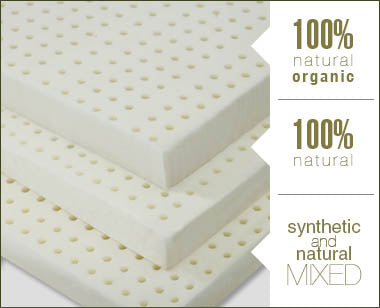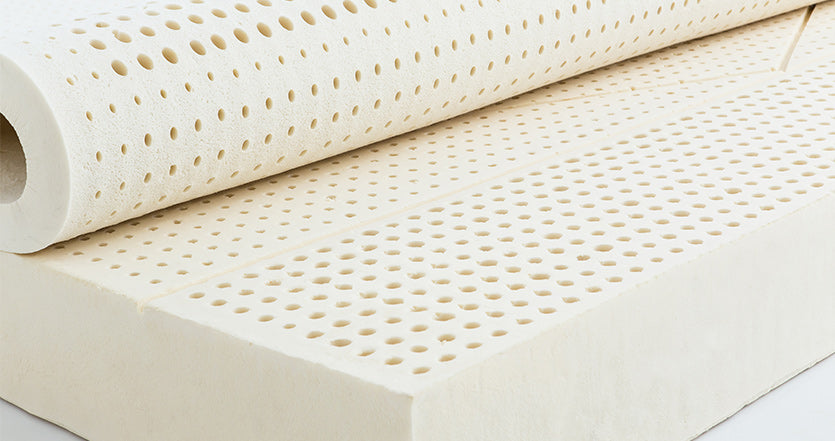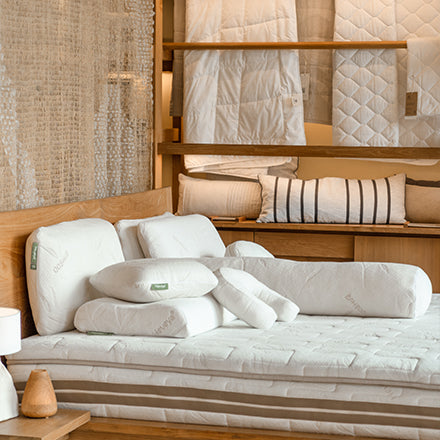
If you are thinking of purchasing a latex mattress, you have made a good choice already. Latex offers a truly wonderful combination of support and comfort which owners love. Benefits go beyond comfort; the natural mould resistance, excellent airflow and natural origin of the latex mattress are highly regarded by many.
Indeed, as testament to its relaxing properties, many with back pain find that a latex mattress is by far the best in offering relief.
But beware: not all latex mattresses are created equal. With the huge array of options available, the market can seem bewildering. Rest assured this latex mattress buying guide will help show you what is (and what is not) important in purchasing a good latex mattress.
Organic vs natural vs natural/synthetic blended
Firstly, there is the origin of the latex: natural or synthetic. An all-natural latex mattress is where the latex comes solely from the rubber tree, Hevea Brasiliensis. This is the most desirable option if you are a strong advocate of using raw material derived solely from nature. All-natural latex mattress tends to be slightly more expensive.
An all-natural latex mattress may also be organic. In terms of performance the organic is equivalent to natural latex. Its appeal lies in the organically sourced nature of the product, which is attractive if you are an eco-conscious customer. An organic latex mattress is usually somewhat more expensive than a regular (non-organic) all-natural latex mattress.
Synthetic latex, on the other hand is made by polymerizing a monomer. A monomer is a molecule that binds chemically to other molecules to form a polymer which is then processed to produce latex that looks and behaves similarly to natural.
Note that mattresses are either all-natural, or a natural/synthetic blend of latex. In practice, there are no all-synthetic latex mattresses.
A natural/synthetic blend of latex mattress isn’t necessary inferior compared to a all-natural latex mattress. Most leading latex mattress manufacturers still continue to develop and manufacture natural/synthetic blend of latex mattresses. By mixing synthetic latex with natural latex, they are able to manipulate and achieve the ‘perfect mattress’ that is superior in both comfort and support, consistently. Some of these manufacturers even keep this ‘combination’ a trade secret from their competitors as they do not want their formula to be copied.
As a consumer, if you decide to purchase a natural/synthetic blend of latex mattress, or even for a all-natural latex mattress, just make sure that the bedding store is able to show you the various certifications the mattress has obtained. These certifications are important as they indicate that the latex mattress has undergone rigorous testing of international standard, such as Oeko-Tex, Eurolatex, LGA and Morton Thiokol - to certify that the latex core excels in durability and elasticity, does not contain any harmful substances and poses no risks to the sleeper and the environment.

Processing method: Dunlop versus Talalay
Latex (whether natural or blended) can be processed in one of two different ways to create the latex blocks for mattresses. One of these is called the Dunlop method, the other is the Talalay method.
It's not important for us to know all the chemistry behind these methods. However, it is important to know that these methods result in slightly different mattress properties. The Dunlop method results in a firmer-feeling mattress and forms a single block the size of the mattress. Very often, a softer-feeling can also be achieved by adding a topper of a lower density on top of the main mattress core. In contrast, the Talalay method results in a softer-feeling mattress and is a little more expensive to produce.
This is not a case of one method being superior and one inferior, but instead, a situation where each person will have their own preference based on what feels comfortable when testing out these mattresses.
100% latex vs latex with other materials
Thirdly, there is the distinction between all-latex mattresses versus latex which is overlaid (or under laid) with another material, most typically polyurethane (PU) foam, memory foam, innersprings or a combination of all three. Generally speaking, all-latex mattresses tend to be considered much more desirable than latex combined with another material. This is mainly because PU foam can off-gas (i.e. emit a chemical odour), which is rather unpleasant. Moreover, all-latex mattresses are more lasting and do not lose their support or shape easily compared to any other mattress materials.
While these different types of latex mattresses may seem bewildering to you, simply remember that all-natural or a natural/synthetic blended 100% latex mattresses are usually considered most desirable. Such mattresses may be made by one of two processing methods (Dunlop and Talalay), neither of which is 'better' or 'worse' but instead which simply result in a different overall feel and different level of firmness to the mattress.
Firmness level
You'll need to try out different levels of firmness to decide which one is right for you. Like other mattresses, latex offers various levels of firmness. These range from a soft one which gives you a soft 'sinking' feeling to a very firm mattress.
Do take note that you shouldn’t be confused or overly concerned between firmness and hardness. Firmness is usually measured by mass per unit volume (kg/m3) and hardness is measured either by using kPa (kilo-pascal) or ILD (indentation load deflection). You can find out more about the difference between density and hardness of latex mattress in this website.
You can only determine the right firmness level that suits you best by laying and testing it out.
What are the pinholes about?
You have probably noticed from online photos that latex mattresses are punctuated with a series of pinholes. These holes serve two purposes. The first is to provide excellent airflow for proper hygiene. This keeps the mattress cool and allows moisture to escape easily, an important issue in warm humid climates.
The second function of the pinholes is to fine-tune the firmness. While the firmness is largely determined by the composition of latex in the mattress, the pinholes play a role too. The size and number of pins affect the level of comfort and firmness you experience. In fact, some latex mattresses have the pinholes arranged differently in different parts of the mattress, allowing you to experience different zones of softness and firmness for ultimate body support. Other latex mattresses have a uniform arrangement of pins. This all comes down to what you're seeking and what you feel is most comfortable for you when testing out mattresses. A mattress isn't something you buy every day - in fact the chance to do it comes only about once every 10 years. So, treat yourself to whatever offers you the most relaxation and pressure relief. For some, this could be a latex mattress with a variable arrangement of pins, while for others, it could be a latex mattress with a uniform arrangement of pins.
Rest assured that you will not have to count the pinholes to determine whether you have a good quality latex mattress. You can determine that by lying on it: a good quality latex mattress with sufficient pinholes will feel comfortable to you.
Do I need a multi-layer latex mattress?
You may have noticed that some latex mattresses are one layer (one block) while others are made of two or more layers. The multi-layer mattress will be enclosed in a sturdy removable cover. At first glance, a single layer and multi-layer latex mattress will look alike. If you are curious though, you can easily examine the layers in a multi-layer mattress when you unzip the cover.
A multi-layer latex mattress offers some added benefits over single layer mattresses. The first of these is personalized comfort. Different levels of softness and firmness can be stacked to create the perfect sleeping experience for you. In stacking layers, the softest layer is usually placed on top for comfort and the firmer layer at the bottom to provide a good support base. However, you can have the layers the way you want; stacking offers you plenty of different combinations to try. The key here is to find the arrangement which makes your body most comfortable.
The other benefit of a multi-layer mattress is the ability to later change out a layer if you desire. For example, a lifestyle change may occur and you might decide you want to change out one of the layers for a different level of firmness. This is much easier and more convenient for you than replacing the entire mattress.
However, the question of whether you need a multi-layer latex mattress is a personal decision which only you can make. In general, all other things being equal, a multi-layer mattress is considered more desirable than a single block. For example, a 15-cm layer plus a 5-cm layer tend to be considered better than one 20-cm layer. This is because of the reasons of customisability given above. Yet ultimately there is no right or wrong here, but rather this is something you will need to test out by lying on different mattresses.

Look for certifications
The best quality latex mattresses have certifications. Certifications are indicators that the mattress has passed certain stringent tests or adheres to specific international standards. Certifications may also be given for being manufactured in a particular way.
The certifying bodies are extremely stringent about their standards and these certifications are not awarded easily. So, if a particular brand and model of latex mattress has been awarded certifications, this is a good sign that you're looking at a high-quality product.
Do I need a warranty?
Yes, a warranty is a must! Don't be tempted to buy a mattress without a warranty: it will be of poor quality. Only buy a mattress which the manufacturer or seller is willing to stand behind with a warranty. No matter how good a deal seems, there's a catch in it for you if there's no warranty. A high-quality latex mattress will always come with a warranty period of at least 10 years.
The bottom line when shopping
As you can see, there are factors that matter when shopping for a latex mattress and some other criteria that are optional.
The must-haves:
- All-natural latex or natural/synthetic blended 100% latex mattress (not combined with other materials)
- Sufficient pinholes that allow the mattress to ventilate well
- Certifications awarded by recognised international bodies
- Warranty of at least 10 years
Features up to individual preference:
- Organic vs all-natural latex versus natural/synthetic blended
- Desired level of firmness
- Latex processed by Dunlop vs Talalay method
- Multi-layer vs single-layer mattress
Now that you have identified the must-have features versus those which come down to your personal preference, mattress shopping will be easier and more pleasurable for you.
Remember that the aim of shopping for a latex mattress is to ensure your utmost comfort. So, enjoy the process of seeking out your perfect mattress!



